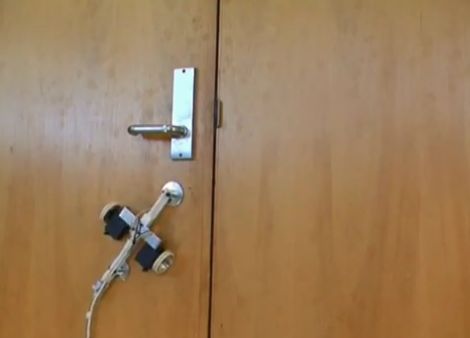
Watch out Spidey, there’s a new wall climber in town!
Researchers [Matthew Journee, XiaoQi Chen, James Robertson, Mark Jermy, and Mathieu Sellier] recently unveiled their wall climbing wonder bot at the 2011 IEEE International Conference on Robotics and Automation. Like most other wall climbing bots, theirs operates on the Bernoulli principle to keep it stuck to the surface, but that’s where the similarities end.
Unlike other Bernoulli-based climbers, this robot’s gripper never actually touches the surface it is climbing. The researchers were able to accomplish this feat by designing a specialized gripper which forces air through a 25 μm gap, creating a very powerful low pressure vortex. The gripper’s design compresses the air by shape alone, causing the air flow to reach speeds of Mach 3, without relying on powerful pumps or increased air volume.
The researchers state that their supersonic gripper can support about five times the weight of a conventional Bernoulli gripper, and as you can see in the video below it also has no problem climbing a wide variety of surfaces.
Window-washing Roomba, here we come!
[via Make]
[youtube=http://www.youtube.com/watch?v=eEcDS1Vhp3o&w=470]















The gripper’s design compresses the air by shape alone, causing the air flow to reach speeds of Mach 3, without relying on powerful pumps or increased air volume.
Does this imply that the hose could be replaced by a low power pump?
How many SCFM of air does this need to operate? It it needs a 10 hp pump to operate, then it isn’t really that practical for most applications.
Also – if the air stops… gravity takes over.
these guys are going to make a fortune in the window cleaning business!
So here’s our new wall climber. It’s only 2lbs. Amazing. it also comes with 58lb HVLP air compressor to make it work and is attached to it via a 4′ hose but ignore that fact.
Still… nice achievement!
Crap, I was ignoring that fact… now I’m all disillusioned. :( Stupid reality!
Shananigins! Awesom suction cup thing. FAIL on %90 of the device off of the main chassis.
That sucks so good!
Actually, it blows so good! … at the same time, I was a bit disillusioned by the description claiming “a very powerful low pressure vortex” in a system where vorticity is not necessary or relevant. This is a system where the energy due to motion has been converted to pressure, there are not appreciable viscous forces.
It still has lots of practical applications. It seems capable of lifting a reasonable weight. So I assume that a bigger version with a fatter air pipe could lift even more?
Great for running cables up the side of a building without having to go up a ladder. Especially if you modified it to shoot staples into the wall to secure the cable as it goes up.
It’s really quite impressive.
Wow, maybe we could start traveling in tubes or tunnels with these things. An array of these devices on the top and the bottom pulling the vehicle up and down at the same time to make hover. Then a nominal orthogonal force could propel the vehicle. Maybe even achieved with a single propulsion device.